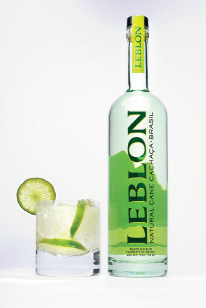


![]()
ONLINE

Editors' Note
Prior to creating Leblon with his Brazilian father-in-law, Steve Luttmann was Senior Vice President of Marketing at LVMH Moët Hennessy Louis Vuitton in New York from 2002 to 2005. Luttmann’s immersion in the beverage category began with a 10-year stint at Unilever, where he handled product introductions in South America and worked in different divisions of the multinational firm in the U.S., Brazil, and Austria. It was during this period that he was Marketing Director for Lipton Tea & Beverages. He earned an M.B.A. from the NYU Stern School of Business in New York in 1992, specializing in Marketing and International Business. He graduated from Pennsylvania State University with a B.S. in Finance and Economics with Honors in 1987.
Company Brief
Leblon Cachaça was created to shine light on Cachaça, the third most-consumed spirit in the world, and the key ingredient to Brazil’s national drink, the Caipirinha. Cachaça is made from fresh-pressed cane juice fermented and distilled, and can only come from Brazil. Leblon Cachaça is produced at a distillery in Patos de Minas, in the heart of Minas Gerais, Brazil’s prized sugar cane region. The company (www.leblon.com) combines traditional approaches with creative European winemaking techniques, including aging the spirit in XO cognac casks, to create their artisanal Cachaça.
When we started in 2005, the awareness was as close to zero as possible in terms of Cachaça and Caipirinha. But now, the Caipirinha is already at 30 percent awareness and Cachaça is at 20, which I’m happy about because those are mainly the front line, the few who reach the many, both bartenders and bar aficionados.
Yes. The main thing was the growth of “Brand Brazil.” The country is becoming prominent in the world, and there has always been a desire, particularly in North America and Western Europe, for a Latin solution. It’s been a perfect mix in terms of the economic and cultural growth. In addition, Cachaça is a white spirit, so it has broad mixability and usage, and the Caipirinha is essentially a margarita made like a mojito. The Caipirinha goes great with food, and it’s not polarizing, so it’s broadly accepted.
Tequila is suffering from an agave shortage, so we see tequila and margaritas markets as our opportunity. Cachaça is a value opportunity, but within that opportunity, we want to be on the high end and put our stake in the higher quality segment of that category.

When we started, it was 20,000 cases – it’s now over 100,000 9-liter cases in less than five years. Everyone seems to be jumping in, which is good news. It seems to be developing long term. It could develop very similar to the tequila category with a lot of different entrants, price points, positionings, qualities, and points of view on how to make their particular product.
In this space, trends go through the bartender and there are very influential bars, particularly in New York, Miami, Los Angeles, and San Francisco. We put a lot of focus and education into those bar and restaurant accounts. We are in every state in the U.S., as well as in Western Europe and Brazil, but we still focus on what we call the cultural capitals, which are the four markets I mentioned, but also Paris, London, Sao Paolo, and Rio. We’re also working with national accounts, like the China Grill Managements and Marriotts of the world.
The U.S. government currently requires that all Cachaças include the term “Brazilian rum” on their labels. However, that creates a lot of consumer confusion. They taste the product expecting a rum and it tastes very different. Our goal is to get the same recognition that cognac got in terms of having Brazilian rum come off the label, especially since Cachaça is the third most-consumed spirit in the world. Cachaça was created in 1532 and rum was created in the Caribbean 100 years later, so we always joke that if anything, rum should be called Caribbean Cachaça and not vice versa. There was a time when tequila had Mexican whiskey on the label. It’s time Cachaça stood on its own as well.
There has been a process initiated through the Brazilian government and a group of Cachaça producers called IBRAC, petitioning the U.S. government regulator in this area called the TTB. We’ve been successful in getting them to draft a Notice of Public Rulemaking, which is essentially a resolution recognizing Cachaça as its own product group thus allowing the reference to Brazilian rum to come off the label, and requiring all Cachaça to be from Brazil, and having an appellation control law recognized.
It’s a white spirit, so it has a very broad usage. It’s highly mixable, it goes real well with fruit, you can drink it on the rocks, with tonic, or with a twist of lime. A lot of people are doing twists on the classics, so instead of a cosmo, they’ll take out the vodka and put in Leblon and call it a Sao Paolo cosmopolitan; or they will do a Brazilian margarita or a Leblon martini.
I did. I have always worked on more entrepreneurial projects, either turnarounds or from-scratch brands and new products. I kind of grew out of the big company requirement, and on my 40th birthday, I started Leblon. It’s very difficult to do new products and innovations within a corporate environment, particularly the companies that are large and mature. Most innovations, whether in consumer products, technology, or wine and spirits, come from entrepreneurs.•